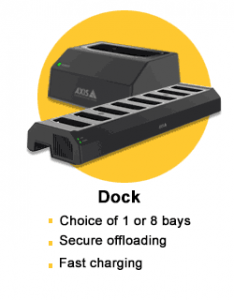Recognised industry leaders, Axis Communications have entered the body worn market with a versatile, cost-effective and easily scalable solution.
From train attendants and at-risk retail workers, to emergency services and private security personnel; body worn surveillance solutions are commonly used as an effective way to deter bad behaviour and positively influence the actions of both the camera wearer, and the general public. The Axis body worn solution will enable users to capture high-quality footage of encounters that can be used for internal investigations, training or as evidence.The body worn range consists of three main hardware components: the camera (peripheral model also available), the docking station (with 1 or 8 bays) and the system controller. In this post we'll explore how to build your solution, how it can be used to capture and effectively utilise video evidence, and how to integrate your system within professional video management systems (VMS).
Why body worn?
Body worn solutions are an ideal choice for applications that require non-invasive, on-person recording of encounters. Wearable IP cameras enable users to record a personal view of incidents and Axis' solution also offers high-quality audio to complement video - providing a more comprehensive visual and audio account. This can then be used for internal investigations, or in court as evidence.
Wearable IP cameras are often used by police and private security companies to capture evidence of incidents, such as confrontations at night clubs or house raids. However, its potential applications go far beyond that of law enforcement; body worn cameras can be used to make workers, such as bus and taxi drivers, as well as customers, feel more safe. Footage captured through a body worn solution can also be a useful training tool. For example, paramedics can be taught how to safely reach a patient through analysis of footage from the field. Equally, portions of an encounter between a traffic warden and a driver could be used as the basis for testing how trainees respond to similar circumstances.
Building your system
So now the next question is: 'how do I build my own body worn system?' To answer this, let's look at how the individual components of the body worn system fit together and how you can integrate the solution into your VMS.
1. The camera

The first thing you'll need is a camera for recording your footage.
The standalone W100 is able to store up to 30 hours of recorded video footage in full HD 1080p resolution and has a battery life of up to 17 hours. It's water resistant, so can be used reliably outdoors and features dual microphones for high-quality audio.
A secondary peripheral camera can also be plugged into the W100. The TW1200 is a much smaller sensor unit and is also full HD capable. It offers users a flexible recording position and can be worn comfortably on a variety of workwear such as helmets or epaulettes.
2. The docking station

Once you've recorded your footage, you'll need to extract the data from the camera and recharge it.
The W700 docking station automatically and securely extracts data from your camera once it's docked. The sturdy, splash-proof unit also recharges your cameras quickly so they're always ready-to-go. There is a choice of 1 or 8 bay units, meaning you can easily add more cameras to your system with just one dock for multiple cameras.
Once docked and data has been extracted from the cameras, the docking station transfers this data to the final component of your body worn system: the system controller.

3. The system controller
The final thing you'll need is an Axis W800 System Controller.
The system controller acts as the central integration and management point for Axis body worn solutions. Data is offloaded from cameras here via the dock and is then sent to your chosen VMS for management.
Since the controller and dock are both standalone units, Axis' solution makes it easy and cost-effective to scale up your system by adding more cameras and docks as you need to.
Management and integration options
Once you've built your system, how do you manage your footage?
In-the-field users can review footage as well as add categories, descriptions and notes via the Axis Body Worn Assistant mobile app. For more sophisticated video management, the system can be integrated into various VMS systems - enabling management and archiving of footage.
You have the option of integration with Axis VMS or third-party applications, such as Milestone XProtect.
Axis Camera Station
Integration with Axis VMS is a fairly straightforward process - especially since the body worn system has been designed to integrate directly into Axis Camera Station. One licence is required per camera in the system; so whenever you add a new camera you'll need to purchase a new Axis Camera Station licence.
Milestone XProtect
Integration with third-party systems requires the use of the Axis Optimizer Body Worn Extension software. This extension essentially enables a secure connection between the Axis body worn system and your chosen VMS. It also enables users to record, tag and share video with office-based investigators who can then utilise Milestone XProtect to search for and manage video evidence.
In terms of licensing, each user in your system uses one XProtect device licence; so you'll need a new licence for every user you add.
The process of integrating your body worn system into XProtect is illustrated in greater detail in this video:
Gather the evidence you need
Axis' entry into the wearable market presents a versatile and easily scalable body worn solution that can be used within a range of applications.
We've discussed the benefits of employing the Axis body worn system and how you can build your own solution, then integrate it with your choice of VMS. If you'd like to discuss how to set up your own Axis body worn system further, or would simply like some more information, you can give us a call on 0151 633 2111 or contact us online.



